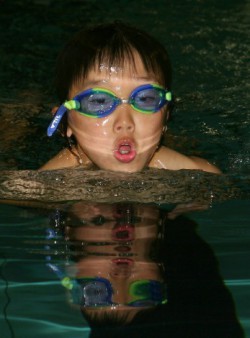Our children are our future—and understanding and supporting their natural yearning for physical activity will help lead them to a lifetime of happy and healthy living. If we joyfully teach them how to include healthy exercise from the early stages of their development, we will be giving our children a gift that will endure throughout their lives.
Among the many benefits are physical fitness, confidence and stronger self-esteem, more energy, better memory, and simply a good feeling about themselves—and they are easy to achieve. Our Take The Magic Step® team is as concerned as many of you about the growing problem of childhood obesity and the lack of exercise in their lives. Whether this obesity and inactivity is caused by the popularity of video games or the declining hours of physical education in schools, it is a wake-up call for everyone. Happily, there are ways of reversing this growing trend and helping our children to enjoy daily exercise and outdoor activities, which they love given the opportunity.
Our “Children’s Fitness and Health Program” is geared towards parents and educators, and focuses on creative ways to incorporate exercise into our children’s everyday routine. Outdoor games and playful workout routines can be the tools that instill lasting joy of exercise. I was so lucky that I was introduced to, enjoyed and benefitted from these activities during my childhood. It created in me an appreciation and understanding of the complex benefits that fitness and exercise can add to a person’s wellbeing. Over the years I’ve been fortunate to share this lasting experience with many children and young adults. (I hope you find additional information in the “Families” section of this Web site).
To emphasize once again the importance of exercise, I have put together some of the health benefits an active child can expect.
Exercise Improves Physical Health
Long-term health benefits of exercise are:
- A stronger immune system! The body’s ability to fight disease is improved. Children are less prone to colds, allergies, and diseases, including cancer.
- A reduction of type 2 diabetes by increasing insulin sensitivity and improving carbohydrate metabolism.
- A lower blood pressure and an improvement of the child’s cholesterol profile.
- A strengthening of the entire cardiovascular system, including the heart and lungs. The heart develops a higher “pump-activity” while the child’s heart and lungs are strengthened, supporting the prevention of heart disease.
- Children are less likely to become overweight and will have better control of their body fat. Overweight children are able to reduce their body weight and body fat due to the physiological effect of burning fat while exercising.
- Children develop stronger bone structure and muscle structure.
Active children enjoy additional health benefits, because:
- Exercise increases the blood flow to all body tissues, including the brain. Greater blood flow transports more oxygen and nutrients to the body’s cells.
- Active children improve their body’s ability to absorb oxygen through aerobic exercise. Due to the increased oxygen in their body’s cells they feel more energized. More oxygen translates into more energy!
- Increased blood flow promotes the body’s transportation of the byproducts of metabolism and toxins back from the cells for elimination, recycling, or further use elsewhere. Children who exercise feel fitter and more energized because of their body’s ability to detoxify.
- Active children breathe better and sweat more. Breathing and sweating are great ways to detoxify the body and help it keep itself “clean.”
- Children increase their over-all fitness through exercise(1).
Exercise Improves Mental Health

© Betty Shepherd
- Exercise enhances the brain’s metabolism. Studies show that active children have improved memory as a result of better brain function!
- Moderate, fun-oriented exercise literally burns off excess harmful hormones and, at the same time, increases the release of beneficial ones. One of the beneficial hormones acts as neurotransmitter for establishing new memories.
- Active children have the ability to concentrate much better, even at the end of a long school day.
- Studies report that exercise decreases anxiety, reduces depression, and improves mood and outlook in children. In addition, their quality of sleep is improved.
Perhaps most importantly, physical activity develops children’s self-esteem and confidence. Their ability to overcome difficult situations improves and they simply enjoy a better, sunnier outlook on life.
To parents and educators: Your efforts to encourage our children to exercise more and instill in them the wisdom of good nutrition and a healthy lifestyle will yield years of dividends in these young people’s lives. (… and the benefits mentioned are for adults too.)
To YOU CHILDREN: I wish you enjoyment of all your outdoor activities, your exercise, and your school! We are always with you!

Reference:
(1) Gavin ML (Medical Editor, KidsHealth.org), Dowshen SA (Chief Medical Editor, KidsHealth.org), and Izenberg N (Editor-in-Chief and Founder, KidsHealth.org): Fit KIDS. 1st edition, DK Publishing, Inc., New York, NY 2004.
Updated April 1, 2011
Copyright © 2006-2012 Uta Pippig





 Oftentimes, toddlers refuse a massage. When it happens, respect their wish as it sends a clear message that their body is completely theirs and others will respect it. Obviously, you should respond properly when they wants a massage. You may be busy at certain times, but if you can establish a predictable schedule, both of you will feel more comfortable. Accommodating your children’s needs show them that you’re being helpful in guiding them toward independence and self-reliance. Remember that childhood needs that are properly met will go away, while those that can’t be met will be carried well into adulthood.
Oftentimes, toddlers refuse a massage. When it happens, respect their wish as it sends a clear message that their body is completely theirs and others will respect it. Obviously, you should respond properly when they wants a massage. You may be busy at certain times, but if you can establish a predictable schedule, both of you will feel more comfortable. Accommodating your children’s needs show them that you’re being helpful in guiding them toward independence and self-reliance. Remember that childhood needs that are properly met will go away, while those that can’t be met will be carried well into adulthood.